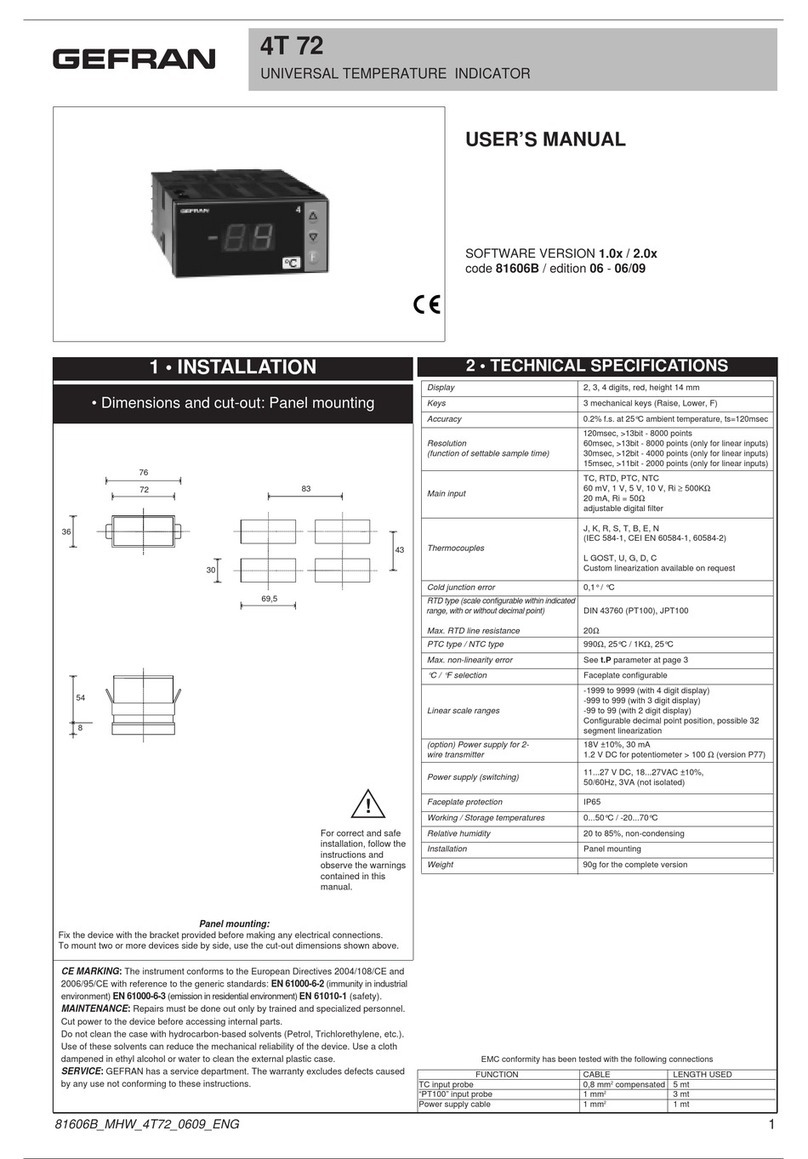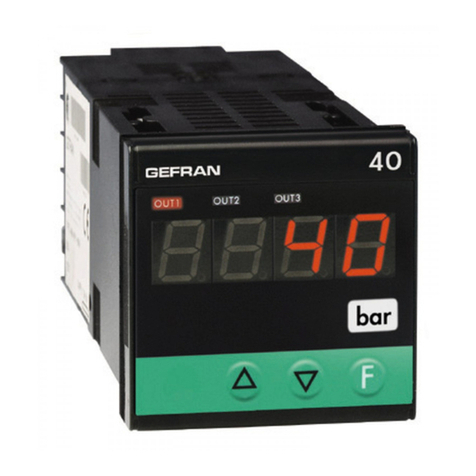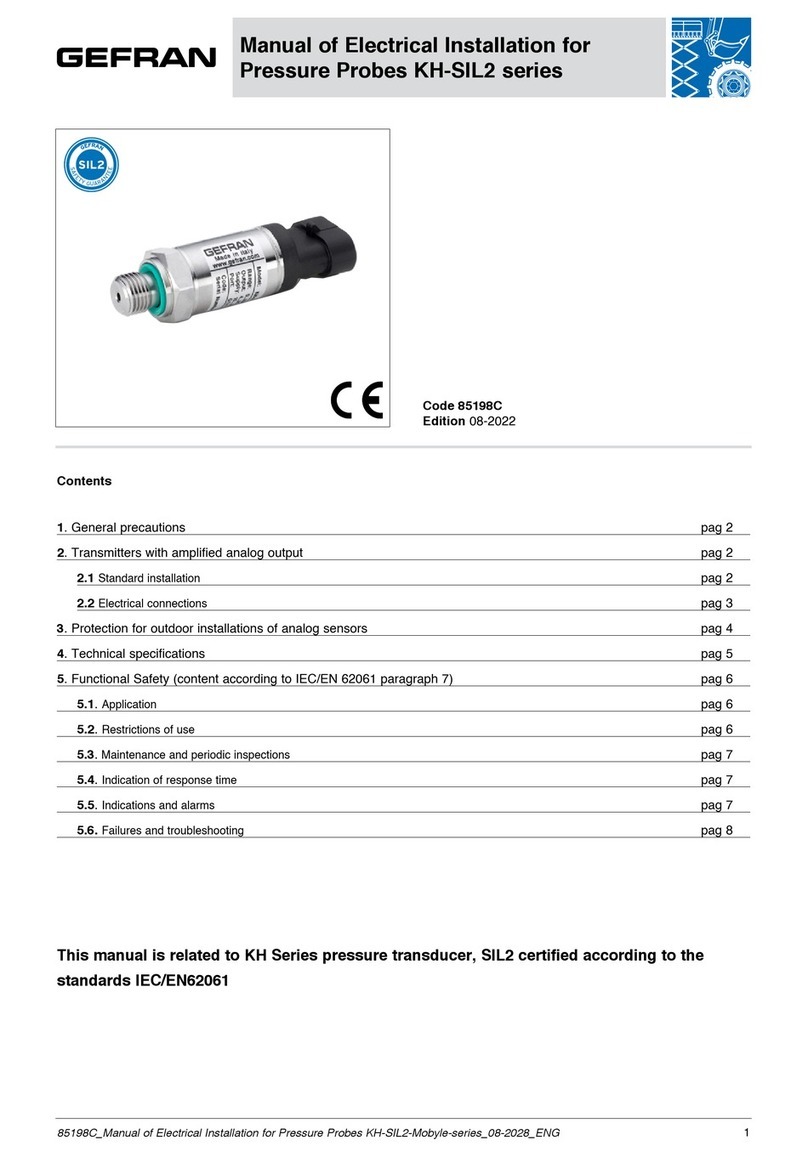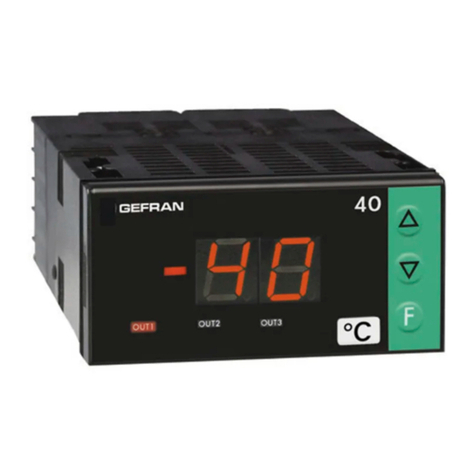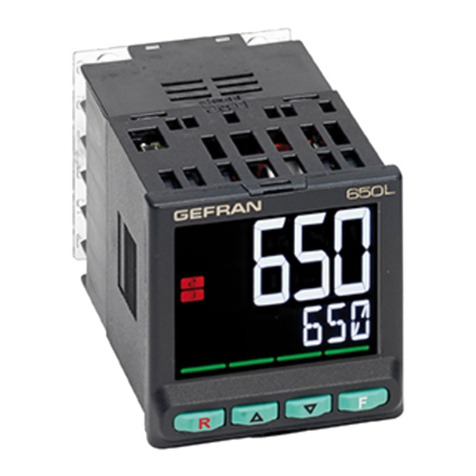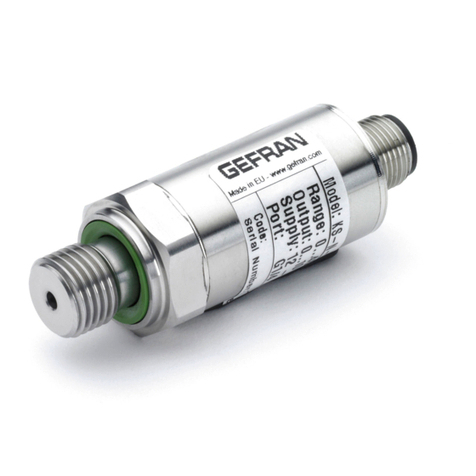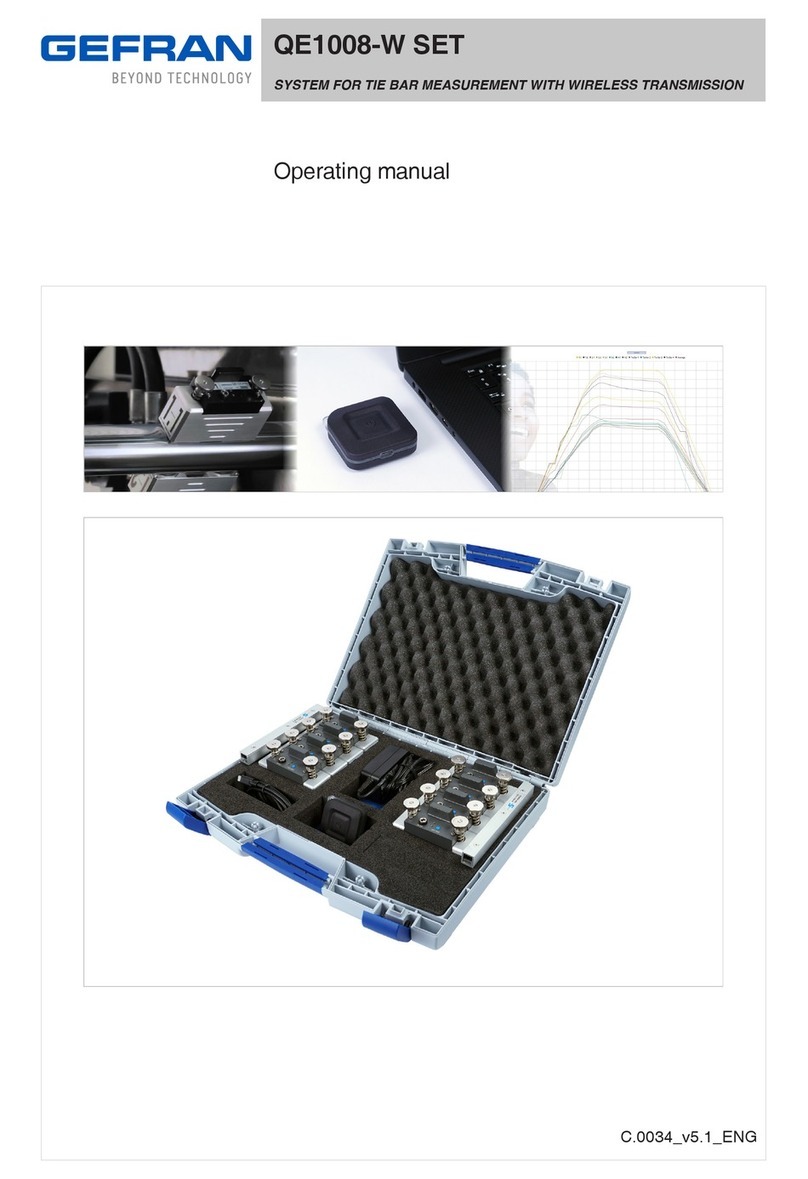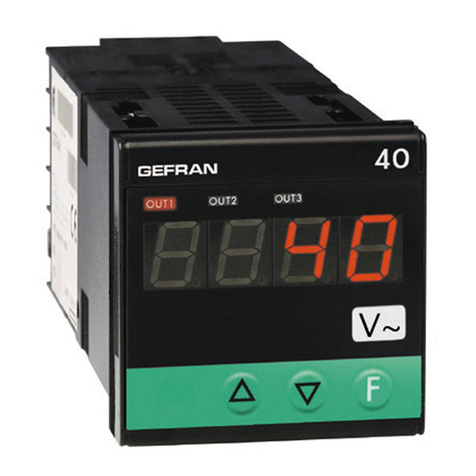5
LINEARI TC/RTD
-999...9999 campo scala
selezione del tipo di
intervento per l'allarme
n° primo
allarme
n° ultimo
allarme
8c • Configurazione
Visualizzazione
Protezione
Software
Velocità di trasmissione
in comunicazione seriale
codice strumento
per
comunicazione
digitale
n° di canali
effettivamente
utilizzati
accesso alla
fase di
configurazione
Premendo CFG
per 10sec.
Prot Config. Impostazione
allarmi
0 abilitata abilitata
1 abilitata disabilitata
2 disabilitata abilitata
3 disabilitata disabilitata
b baud rate Protocollo Parità Interfaccia
0 1200 bit/sec Cencal CL/485
1 2400 bit/sec Cencal CL/485
2 4800 bit/sec Cencal 485
3 9600 bit/sec Cencal 485
4 1200 bit/sec Modbus nessuna 485
5 2400 bit/sec Modbus nessuna 485
6 4800 bit/sec Modbus nessuna 485
7 9600 bit/sec Modbus nessuna 485
8 1200 bit/sec Modbus pari 485
9 2400 bit/sec Modbus pari 485
10 4800 bit/sec Modbus pari 485
11 9600 bit/sec Modbus pari 485
12 1200 bit/sec Modbus dispari 485
13 2400 bit/sec Modbus dispari 485
14 4800 bit/sec Modbus dispari 485
15 9600 bit/sec Modbus dispari 485
Per mezzo dei tasti
" ∆ ∇ " selezionare un
n° nel campo 0...9999
Impostare il n° di canali
(1...8) effettivamente
utilizzati
(+ 8 per abilitare la
scansione automatica)
Impostando 0 si passa alla
configurazione dei canali;
impostando 1...10 si
passa alla configurazione
degli allarmi
= 0
configurazione
ingressi
Selezione
del canale
da 1 all'ultimo canale
selezionato
0 = ritorno alla fase di
configurazione allarmi
Selezione del tipo di sonda d'ingresso
0 J 0...800°C / 32...1472°F
1 K 0...1300°C / 32...2372°F
2 R 0...1600°C / 32...2912°F
3 S 0...1760°C / 32...2912°F
4 T -100...400°C / -148...752°F
5 0...20mA
6 4...20mA
7100mVac (solo config. HW)
8 0...20mV
9 0...50mV
10 0...100mV
11 0...10V
12 Pt100/2 -200...400°C / -328...752°F
13 Pt100/2 -99,9...100,0°C / -99,9...212,0°F
14 Pt100/3 -200...400°C / -328...752°F
15 Pt100/3 -99,9...100,0°C / -99,9...212,0°F
16 Potenziometro
Impostazione del
valore minimo di
scala
Impostazione del
valore massimo
di scala
Filtro digitale
Impostazione
del punto
decimale
0 = filtro incluso
1 = filtro escluso
LINEARI
premendo i tasti
"Incrementa / Decrementa"
il punto decimale si sposta
TC/RTD
decimale fisso
filtro 1,2Hz
allarme 3...10
canale 1...8
(fisso)
t > F
AND (C = 31)
allarme attivo
0se tutti gli allarmi
sono attivi (ON)
allarme attivo se
1almeno 1 degli allarmi
è disattivato (OFF)
OR (C = 32)
allarme attivo se
0almeno 1 degli
allarmi è attivo
(ON)
allarme attivo se
1tutti gli allarmi sono
disattivati
(OFF)
impostazione del
valore di soglia
dell'allarme
impostazione del
valore di isteresi
dell'allarme
impostazione del
tipo di intervento
dell'allarme
allarmi assoluti
0allarme attivo
sopra la soglia
1allarme attivo
sotto la soglia
allarmi relativi
0allarme attivo
sopra (soglia+assoluto)
1allarme attivo
sotto (soglia+assoluto)
allarmi simmetrici
0allarme attivo fuori
dall'intervallo
1allarme attivo dentro
l'intervallo
= 1...10
configurazione
allarmi
impostazione (allarme 1 e 2) e
visualizzazione (allarme 3...10)
del canale associato all'allarme
C = 31 o 32
(funzione AND / OR)
C = 1...30
(allarme normale)
Tutti gli allarmi
0 allarme non inserito
1...8 allarme associato al canale 1...8;
il set point dell'allarme è assoluto
Solo allarmi 1 e 2
9 allarme associato a tutti i canali; il set point
dell'allarme è assoluto; l'allarme è attivo
se tutti i canali sono in condizione di allarme
10 allarme associato a tutti i canali; il set point
dell'allarme è assoluto; l'allarme è attivo
se almeno un canale è in condizione di
allarme
11...18 allarme relativo associato al canale 1...8;
il set point dell'allarme è relativo al set point
dell'allarme (3...10) associato allo stesso
canale
19 allarme associato a tutti i canali; il set point
dell'allarme è relativo, per ogni canale, al
set point dell'allarme (3...10) associato allo
stesso canale; l'allarme è attivo se tutti i
canali sono in condizione di allarme
20 allarme associato a tutti i canali; il set point
dell'allarme è relativo, per ogni canale, al
set point dell'allarme (3...10) associato allo
stesso canale; l'allarme è attivo se
almeno un canale è in condizione di allarme
21...28 allarme associato al canale 1...8; il set point
dell'allarme definisce una finestra di
intervento simmetrica intorno al set point
dell'allarme (3...10) associato allo stesso
canale
29 allarme associato a tutti i canali; il set point
dell'allarme definisce, per ogni canale, una
finestra di intervento simmetrica intorno al
set point dell'allarme (3...10) associato allo
stesso canale; l'allarme è attivo se tutti i
canali sono in condizione di allarme
30 allarme associato a tutti i canali; il set point
dell'allarme definisce, per ogni canale, una
finestra di intervento simmetrica intorno al
set point dell'allarme (3...10) associato allo
stesso canale; l'allarme è attivo se
almeno un canale è in condizione di allarme
31 funzione AND di più allarmi (3...10)
32 funzione OR di più allarmi (3...10)
Nota: da 9 a 30, nel caso di U=1, l’intervento
dell’allarme nelle condizioni di OR e di AND
dei canali é invertito.
LINEARI TC/RTD
-999...9999 campo scala
8d • Calibrazione
Visualizzazione CAL selezione del
canale da
calibrare (1...8)
visualizzazione del tipo di
sonda da calibrare
n° del canale
selezionato
per mezzo di un apposito
calibratore o generatore
trasmettere al corrispondente
ingresso il segnale pari al
valore min. della scala.
Per ingresso 4...20mA fornire
un valore minimo di 0mA
n° del canale
selezionato
trasmettere al
corrispondente ingresso
dello strumento il
segnale pari al valore
max. della scala
visualizzazione
impostazione
temperatura ambiente
* solo per TC
se presente il
ponticello S17
(vedere par. 7)
Il passaggio tra le fasi di calibrazione avviene tramite il tasto CAL; premendo il tasto F si torna sempre in visualizzazione
ATTENZIONE: Lo strumento viene fornito calibrato; l'eventuale calibrazione sul campo deve essere effettuata da un Tecnico Competente e munito
delle apparecchiature necessarie. L'operazione è irreversibile.
Il passaggio tra le fasi di configurazione avviene tramite il tasto CFG; premendo il tasto F si torna sempre in visualizzazione
sese
CFG
F
CFG
(vedere par. 8c)
(*) Negli allarmi simmetrici con isteresi negativa, l’isteresi
è posizionata all’interno della fascia di relatività mentre
con isteresi positiva si posiziona all’esterno.
L’allarme di minima (isteresi positiva, tipo intervento 1) è
automaticamente escluso nella fase di avviamento finchè
la variabile di ingresso non abbia superato la soglia
impostata.
(*)
Assoluti = campo scala
Relativi = -999...9999
Ist. 1 ÷ 2 = -999...9999
Ist. 3 ÷ 10 = -128...127

